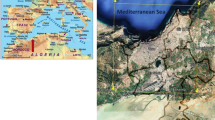Abstract
Istanbul is the most populated city of Turkey with a population of around 10.58 M (2000) living on around 5,750 km2. In 1980, the population was only 4.7 M and then it has been more than doubled in only two decades. The population has been increasing as a result of mass immigration. An urbanization process continues and it causes serious increases in urban areas while decreasing the amount of green areas. This rapid, uncontrolled, and illegal urbanization accompanied by insufficient infrastructure has caused degradation of forest and barren lands in the metropolitan area, especially through the last two decades. The watershed basins inside the metropolitan area and the transportation network have accelerated the land-cover changes, which have negative impacts on water quality of the basins. Monitoring urban growth and land cover change will enable better management of this complex urban area by the Greater Istanbul Metropolitan Municipality (GIMM). A temporal assessment of land-cover changes of Istanbul has been documented in this study. The study mainly focuses on the acquisition and analysis of Landsat TM and Landsat GeoCover LC satellite images reflecting the significant land-cover changes between the years of 1990 and 2005. Raster data were converted to vector data and used in Geographic Information Systems (GIS). A database was created for Istanbul metropolitan area to plan, manage, and utilize statistical attribute data covering population, water, forest, industry, and topographic position. Consequently an overlay analysis was carried out and land use/cover changes through years have been detected for the case study area. The capability of Landsat images in determining the alterations in the macro form of the city are also discussed.
Similar content being viewed by others
References
Anderson, J. R., Hardy, E. E., Roach, J. T., & Witmer, R. E., (1976). A land use and land cover classification system for use with remote sensor data. U.S. geological survey, professional paper 964. Reston, VA.
Cetiner, A., Türkoglu, H., & Güngör, O. (1994). Evaluation of urban environment of Istanbul’s resource areas. Proceedings, planning for a broader Europe VIII. AESOP Congress.
Congalton, R. G. (1991). A review of assessing the accuracy of classifications of remotely sensed data. Remote Sensing of Environment, 37, 35–46.
Devlet Istatistik Enstitusu (DIE). (2000). Nufus Sayimi Sonuclari. Ankara, Turkey. Retrieved May 20, 2003, from http://www.die.gov.tr/nufus_sayimi/2000tablo5.xls (in Turkish).
Ehlers, M., Jadkowski, A. M., Howard, R., & Brostuen, D. (1990). Application of spot data for regional growth analysis and local planning. Photogrammetric Engineering and Remote Sensing, 56(2), 175–180.
Goksel, C. (1998). Monitoring of a water basin area in Istanbul using remote sensing data. Water Science and Management, 38(11), 209–216.
Harris, D. M., & Ventura. (1995). The integration of Geographic data with remotely sensed imagery to improve classification in an urban area. Photogrammetric Engineering and Remote Sensing, 61, 993–998.
Irish, R. (1990). Geocoding satellite imagery for GIS use. GIS World August/September, pp. 59–62.
Jensen, J. R. (1996). Introductory digital image processing, A remote sensing perspective, (2nd edn.). Upper Saddle River, NJ: Prentice-Hall.
Maktav, M., & Erberk, F. (2005). Analysis of urban growth using multi-temporal satellite data in Istanbul, Turkey. International Journal of Remote Sensing, 26(4), 797–810.
Musaoglu, N., Tanik, A., & Kocabas, V. (2005). Identification of land-cover changes through image. Processing and associated impacts on water reservoir conditions. Environmental Management, 35(2), 220–230.
Steininger, M. K. (1996). Tropical secondary forest regrowth in the Amazon: Age, area and change estimation with Thematic Mapper data. International Journal of Remote Sensing, 17, 9–27.
Treitz, P. M., Howarth, P. J., & Gong, P. (1992). Application of satellite and GIS technology for land-use mapping at the rural urban Fringe: A case study. Photogrammetric Engineering and Remote Sensing, 58, 439–448.
Welch, R., Remillard, M., & Slack, R. B. (1998). Remote sensing and geographic information system techniques for aquatic resource evaluation. Photogrammetric Engineering and Remote Sensing, 54, 177–185.
Westmoreland, S., & Stow, D. A. (1992). Category identification of change of land-use polygons in an integrated image processing/geographic information system. Photogrammetric Engineering and Remote Sensing, 58, 1593–1599.
Author information
Authors and Affiliations
Corresponding author
Rights and permissions
About this article
Cite this article
Geymen, A., Baz, I. Monitoring urban growth and detecting land-cover changes on the Istanbul metropolitan area. Environ Monit Assess 136, 449–459 (2008). https://doi.org/10.1007/s10661-007-9699-x
Received:
Accepted:
Published:
Issue Date:
DOI: https://doi.org/10.1007/s10661-007-9699-x




